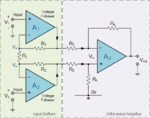doncarlosalbatros
Full Member level 2
Hello,
I'm planning to implement the circuit below I have drawn. But because there is no SPICE for such components I couldn't verify or test any overall workings.

(left-click to enlarge)
From left to right I will first summarize the signal chain:
The transducer is a uni-polar and balanced transducer and it has three terminals marked as SG_out, SG_ref and AGND. It has normally swing of +/-200mV. I want to amplify this transducer signal and send to a 20 meters far away data acquisition input in a balanced way. Signal interest range can vary between +/-100mV to +/-10V and freq from DC up to 30kHz.
The power supply is a +/-15V dual supply where I marked its terminals as +15V, -15V and PWR_GND.
The fixed gain differential amplifier INA106 is chosen for a stable gain and CMRR for temperature changes.
Balanced line driver is right after the differential amplifier is chosen to ensure the balanced output for the transmission.
STP cable carries line driver's outputs all the way to a differential ended and balanced data acquisition inputs. The STP cable's shield is grounded to the ground of the data acquisition ground AIGND.
The data acquisition receives the signals Vo+, Vo- from the STP cable.
If the overall wiring is correct, my questions are:
1-) As you see the STP cable carries Vo+, Vo- and shield but not the analog ground of the incoming signal chain. Does that mean I should ground the balanced driver's ground(from its pin3) with a separate wire to the AIGND as drawn in the schematic? And at what point of the signal chain ground(from AGND to AIGND) is better to connect and ground the power ground terminal PWR_GND? An edit(maybe with a image editor) on my diagram would really help better.
2-) Is my wiring correct or is there any fundamental problem you see?
I would be very glad to hear your opinions before implementing this.
I'm planning to implement the circuit below I have drawn. But because there is no SPICE for such components I couldn't verify or test any overall workings.

(left-click to enlarge)
From left to right I will first summarize the signal chain:
The transducer is a uni-polar and balanced transducer and it has three terminals marked as SG_out, SG_ref and AGND. It has normally swing of +/-200mV. I want to amplify this transducer signal and send to a 20 meters far away data acquisition input in a balanced way. Signal interest range can vary between +/-100mV to +/-10V and freq from DC up to 30kHz.
The power supply is a +/-15V dual supply where I marked its terminals as +15V, -15V and PWR_GND.
The fixed gain differential amplifier INA106 is chosen for a stable gain and CMRR for temperature changes.
Balanced line driver is right after the differential amplifier is chosen to ensure the balanced output for the transmission.
STP cable carries line driver's outputs all the way to a differential ended and balanced data acquisition inputs. The STP cable's shield is grounded to the ground of the data acquisition ground AIGND.
The data acquisition receives the signals Vo+, Vo- from the STP cable.
If the overall wiring is correct, my questions are:
1-) As you see the STP cable carries Vo+, Vo- and shield but not the analog ground of the incoming signal chain. Does that mean I should ground the balanced driver's ground(from its pin3) with a separate wire to the AIGND as drawn in the schematic? And at what point of the signal chain ground(from AGND to AIGND) is better to connect and ground the power ground terminal PWR_GND? An edit(maybe with a image editor) on my diagram would really help better.
2-) Is my wiring correct or is there any fundamental problem you see?
I would be very glad to hear your opinions before implementing this.
